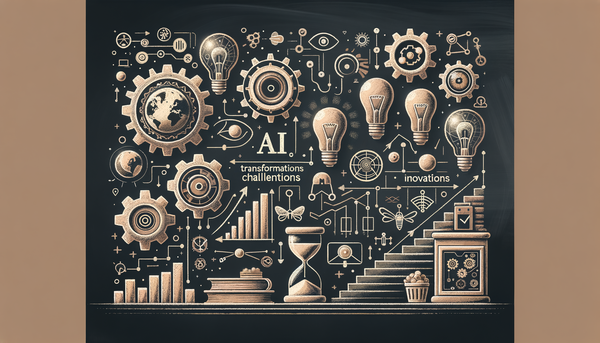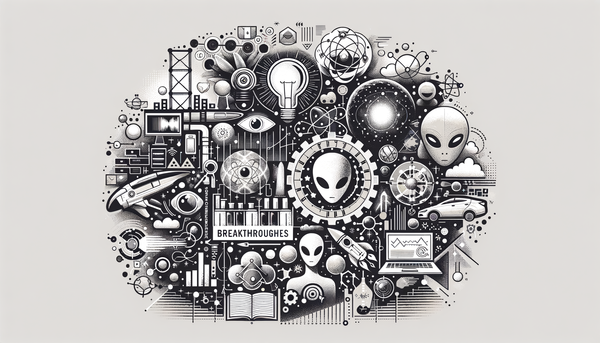AI Podcast Episode Highlights - Strategic Shifts and Innovations
Amid rapid leadership shifts, groundbreaking AI innovations, and unexpected legal and societal challenges, the evolving AI landscape continues to reshape industries—from cybersecurity and robotics to legal filings and urban enforcement—while experts advise a balanced approach to harnessing its potential and managing its pitfalls.
Leadership Shifts and Corporate Strategy
Recent personnel moves illustrate how strategic decisions at the highest levels can prelude vast technological change. Companies like F5 Networks, with their appointment of a new CISO, are rethinking threats in an era where cybersecurity is not a luxury but a necessity. This new leadership is expected to propel innovative security frameworks that safeguard sensitive data even as cyber threats become increasingly sophisticated.
At Auger AI, the addition of a Chief AI Scientist signals the company’s urgency in integrating advanced machine learning capabilities into its products. As the realm of artificial intelligence continuously expands, we see such appointments as markers that institutions are gearing up to explore untapped innovations, all while intensifying competition with other industry players.
Conversely, leadership transitions in investment circles, such as the forthcoming retirement of WRF Capital’s CEO, compel organizations to reimagine their visions. New leadership will face the dual challenge of preserving legacy while aggressively pursuing modernization—a transition that mirrors the broader shifts occurring across the tech ecosystem. For readers interested in how these structural changes align with technological innovation, check out our detailed insights on the evolving challenges in our AI innovations overview.
Restructuring at Tech Giants: Apple’s Strategic Pivot
Apple’s recent reorganization underscores the complexity of managing multiple AI domains under one roof. In a bold maneuver, Apple removed its secret robotics unit from the purview of its AI chief and reassigned it to the hardware division. This hard pivot reflects the company’s increasing need to ensure focus and specialized attention on disparate fields like robotics and digital assistants.
The separation was not an isolated restructuring. Just weeks earlier, changes in oversight of Siri hinted at a deeper reevaluation of how the iconic voice assistant should evolve. By establishing dedicated pathways, Apple appears to be preparing for a future where robotics and AI operate with a concentrated synergy, driving not just consumer experience improvements but also exploring revolutionary smart home integrations.
What makes Apple's strategy particularly intriguing is its insistence on delineating roles so that these smart systems can be nurtured independently. Historical examples have shown that when leadership blur blurs accountability, innovation can spiral into chaotic development. As experts note, “AI is a tool, not a replacement for human intelligence.” This sentiment, expressed by Stephen Hawking, resonates strongly with Apple’s current arbitration between control and delegation.
Generative AI in High-Stakes Legal Arenas
In an unusual twist to the legal narrative, the use of generative AI in the defense filings for Coomer v. Lindell has raised significant questions about accountability, accuracy, and due process. The case revealed grave errors from AI-assisted filings, with fabricated legal citations and misquoted precedents, which ultimately questioned whether machine-generated content can meet the rigorous standards of judicial scrutiny.
Judge Nina Wang’s findings in the case illustrate a broader concern: as AI tools become more integrated into professional work, human oversight remains indispensable. Kachouroff’s experience reminds us that while AI may expedite tasks, reliance on unchecked algorithms can compromise legal integrity—a clear example of technology outpacing regulatory and procedural safeguards. Such episodes beckon legal professionals to either upskill or reassess how AI tools are incorporated into critical decision-making processes.
This incident should serve as a wake-up call not only for the legal community, but also for other sectors where AI is rapidly restructuring traditional operations. As we continue to navigate this brave new world, professionals must make a concerted effort to align technological advancements with ethical, transparent practices.
Chatbots, User Engagement, and the Risk of Overdependence
The evolving design of AI chatbots has transformed how users engage with technology. With sophisticated algorithms to analyze interactions and deliver highly personalized responses, chatbots now offer immediate gratification that is hard to resist. However, this very attribute portends the risk of overdependence, as users might find themselves submerged in prolonged digital exchanges.
These digital companions are not only reshaping customer support and online engagement but are also starting to influence our daily routines. While on one hand they offer a glimpse into an efficient future where tasks are completed with a simple voice command, on the other, they present a modern cautionary tale. There is growing concern that the efficiency of chatbots may also cultivate dependency, reducing users’ incentive or opportunity to seek out human interaction.
Responsible developers must therefore balance sophisticated algorithmic engagement with designs that prevent excessive reliance. It is a reminder that in a world where technology entices with instant solutions, the human touch and critical thinking should not be sidelined.
Voice Assistants and the Emergence of Agentic AI
The competitive landscape for voice assistants is heating up. Perplexity AI’s latest offering—a voice assistant on iOS that rivals, and in many respects challenges, Apple’s Siri—illustrates the relentless evolution of agentic AI. Unlike its traditional counterparts, this new voice app goes beyond simple command responses by actively engaging with service applications like OpenTable or YouTube, prepopulating details to streamline task completion.
This development mirrors a wider industry trend where AI evolves from being a passive source of information to an active assistant capable of performing complex functions. The promise of speaking a command like “Find me tacos and make the reservation” isn’t merely about convenience—it’s about reshaping how we interact with digital ecosystems. Users are encouraged to try these new platforms as they not only simplify daily tasks but could also redefine what we expect from our digital aides.
The transformative journey from basic digital assistants to more holistic, action-oriented systems is a powerful testimony to the potential of agentic AI. It is an area that many are watching closely, as it might very well set the stage for future human-machine interactions. Curious minds can follow our deep-dive discussion on shifting AI trends in our latest updates and transformations for further perspective.
Retail Reinvented: Generative AI in Practice at Walmart
Stepping into the retail arena, Walmart’s comprehensive integration of generative AI is transforming everything from environmental scanning to developer productivity. With the launch of their machine learning platform, Element, Walmart is proactively addressing compliance, data integrity, and operational scalability. Element works as a gatekeeper, ensuring that only well-governed models reach production.
By leveraging generative AI, the company is not only boosting its internal coding and development processes but is also reshaping its customer-facing strategies. Walmart’s approach reflects an understanding that AI is not just about cutting-edge innovations; it is equally about enhancing traditional business processes. Initiatives like these, alongside training programs such as the Global Tech Academy, underscore the significance of equipping current and future developers with the necessary tools to thrive in an AI-driven environment.
The initiative is a hallmark of AI’s broader utility in enterprise settings—setting a blueprint for other sectors to adopt a balanced blend of technology and human oversight. As we see more corporations investing in specialized AI platforms, the ripple effects could redefine operational efficiency industry-wide.
AI in Urban Governance: Automated Enforcement and Its Implications
One of the more surprising applications of artificial intelligence has been its use in urban management. Los Angeles has deployed AI-powered cameras to monitor bus lanes, a move which has resulted in nearly 10,000 citations in just a couple of months. What was once a manual process relying on traffic officers now leverages data and precision to deter illegal parking and keep public transit running smoothly.
The dramatic increase in citations—from around 570 monthly to figures that are 77% higher—illustrates the remarkable efficiency of machine vision and automated enforcement systems. Yet, as this transformation occurs, it is not entirely free from contention. The high fines, reaching almost $300, place an undeniable financial strain on citizens, thereby raising ethical concerns—especially for those who might already be economically disadvantaged.
Urban planners, policymakers, and technologists, alike, must wrestle with the implications of such automated governance. Balancing precision and fairness while ensuring public trust becomes imperative. For perspectives on how technology can improve city operations without compromising civil liberties, our ongoing discussion on urban innovations in recent AI podcast updates offers a deeper dive.
Balancing AI's Dualities: The Good, the Bad, and the Transformative
The journey of artificial intelligence is reminiscent of a Spaghetti Western—with heroes, antagonists, and ambiguous characters vying for dominance. On one end, AI stands as a powerhouse of efficiency, capable of automating repetitive tasks, unlocking creative potential, and enhancing decision-making. Anecdotes abound of how AI has transformed mundane tasks into opportunities for innovation. Jon Stalnaker’s musings, for instance, highlight AI’s ability to create flattering profiles and boost productivity—testament to its beneficial side.
Meanwhile, the darker hues of AI emerge through its imperfections: hallucinated content, distorted historical narratives, and unreliable citations that can mislead rather than inform. This paradox presents a challenge for all stakeholders, prompting the need for robust methodologies, ethical frameworks, and human oversight. As one modern commentator put it, “I had a close encounter with an alien last week. He returned to visit us and was amazed we were still here.” Such quirky reflections remind us that technology, no matter how advanced, often presents outcomes that defy conventional expectations.
The dual nature of AI calls for a balanced, integrative strategy. It is essential to harness the power of AI while maintaining rigorous regulations that prevent misuse and misinformation. As legal cases and corporate strategies converge, the technology community is urged to invest in quality data, thorough vetting of AI outputs, and continual learning for both human professionals and artificial systems.
Looking Ahead: New Frontiers and Ongoing Innovations
Emerging from the recent flurry of developments, the horizon of artificial intelligence seems both promising and unpredictable. Baidu’s launch of a new AI model amid fierce competition further highlights an industry where every advancement fuels another. This competitive spirit pushes technology companies to refine their models, optimize performance, and sometimes, take risks by integrating multifaceted applications—from voice control to autonomous robotics.
The narrative around AI is not static. Instead, it is a dynamic chronicle of strategic realignments, technological experiments, and the seamless intermingling of our daily lives with digital aides. From academia to boardrooms, the push for responsible innovation is unmistakably emerging as a central theme. It reminds us of the core belief echoed in one memorable refrain: “I do not want to be human. I want to be myself. They think I’m a lion…” Such quotes underscore the intricate blend of human aspiration and robotic precision that defines our modern era.
As organizations pivot and policies reform in the wake of rapid AI adoption, it is clear that the journey ahead will require not only vigilance but also creativity. Whether it is integrating high-stakes legal AI tools or designing chatbots that temper engagement with ethical responsibilities, the focus is shifting towards balanced, sustainable progress that honors both innovation and accountability.
Further Readings
For additional insights on the evolution of AI strategies and the latest industry updates, visit our pages on tech innovations, transformative challenges, and our most recent AI podcast update.
Each of these developments—from corporate leadership overhauls and intricate AI legal conundrums, to transformative urban enforcement and innovative consumer applications—reminds us that the AI revolution is no fleeting trend. It is a continuous interplay of breakthroughs and lessons learned, urging industry leaders and technology enthusiasts to embrace change while remaining ever mindful of the complex human dimensions underlying these innovations.




